DOES HONEYCOMB HOUSING CONFLICT WITH FENG SHUI?
A RANDOM HOUSEHOLD SURVEY IN JOHOR JAYA,
A PREDOMINANTLY CHINESE TOWNSHIP
Mohd Peter Davis, Bukryman Sabri and Nurizan Yahaya
Universiti Putra Malaysia
A Report Commissioned by RENEWED DEVELOPMENT SDN. BHD.
12C Metropolis Tower, Johor Bahru.
Report Published
13 April 2006
IN BRIEF
Honeycomb Housing is a new Malaysian innovation from Arkitek M. Ghazali in collaboration with Universiti Putra Malaysia and offers an affordable and environmentally friendly alternative to terrace housing. It is gaining wide support from potential house buyers in exhibitions, amongst housing professionals at seminars and now the Sarawak Government for the Ninth Malaysia Plan. However, Developers are concerned that the departure from rectangular shaped building lots to triangular housing compounds, which link up to form hexagonal cul-de-sacs then honeycomb communities, is too radical and may conflict with Feng Sui beliefs. If true, this cultural objection may deter Chinese house buyers, a major section of the Housing market. To test this serious commercial risk a pioneering Developer (Renewed Group based in Johor Baru) commissioned the University to conduct a random household survey comparing as fairly as possible a RM220,000 Honeycomb house with an equivalent RM220,000 Terrace house in a predominantly Chinese township.
The simple and novel 3 day survey of 150 households randomly selected from about 9000 households comprising Johor Jaya, revealed over 1000 potential customers for the Honeycomb house compared to fewer than 300 for the Terrace house. Although 50% of the Chinese in Johor Jaya agreed that the Honeycomb house conflicted with Feng Sui beliefs, only 33% said they would consult a Feng Sui expert before buying such a house. Whilst the Honeycomb house had particular appeal to Malays (84% of Malays, 56% of Chinese and 58% of Indian respondents preferred the RM220,000 Honeycomb house) there was little resistance amongst the Chinese residents in Johor Jaya. The potential buyers of the Honeycomb house were 352 Chinese, 364 Malays and 294 Indians.
The concern of Developers that Honeycomb housing conflicts with Feng Sui is largely unfounded. The Chinese, Malays and Indians will buy Honeycomb houses in strong preference to terrace houses.
INTRODUCTION
Universiti Putra Malaysia, in close collaboration with Arkitek M. Ghazali, has recently published a book “Thermal comfort Honeycomb housing” (1) describing 17 years of pioneer research to develop an affordable and environmentally friendly alternative to terrace housing. Cluster houses consisting of 2, 3, 4 or 6 units, rather than long rows of terrace houses, are arranged like bungalows in a honeycomb pattern around small neighbourhood parks planted with fruit bearing rainforest trees to shade the roads and provide food for birds and small wildlife. The honeycomb arrangement, offering the same or higher density than terrace housing, reduces the roads and through traffic, discouraging burglary and making the area outside the home much safer for children and more sociable for the residents. This new Malaysian architectural concept has been widely presented to housing industry seminars and displayed at Inventors exhibitions and Home Ownership campaigns. Scientific surveys conducted by UPM at these events, although they cannot claim to be random, have shown over 90% acceptance for the Honeycomb concept and a strong demand (80%) amongst potential house buyers. This new housing form, representing the third wave of Malaysian housing following traditional kampong housing and post Independence urban terrace housing, has been accepted by the Sarawak Government for State housing under the Ninth Malaysia Plan.
However almost without fail, Developers have expressed the concern that Honeycomb housing with its triangular land and sharp angles in parts of the house conflicts with Feng Sui beliefs and might not be acceptable to Chinese house buyers. The purpose of this study is not to discuss or question Feng Sui as a cultural belief but to measure its influence amongst the house buying public. A random household survey was commissioned by a Johor Developer to determine how strongly Feng Sui beliefs were held by estimating the acceptability of Honeycomb housing in Johor Jaya, a predominantly Chinese area. The survey took the form of a preference study comparing, as fairly as possible, a medium cost Honeycomb house with a Terrace house of the same price and similar features such as 4 bedrooms, 3 bathrooms and 2 car ports.
METHODS
Random Survey
stratified random survey of 150 respondents was performed, selecting first the housing areas, then the roads and finally the households to be interviewed by three teams of enumerators. Using a street map of Johor Baru, Taman Johor Jaya (a 15 to 20 year Township covering 520 hectares selected by the Developer,Renewed Development Sdn. Bhd., Registration Number 202807-H) was divided into eight areas defined by the major roads. On the first morning of the survey (24-26 March 2006) three areas were randomly selected from a tin containing the name of the area written on 8 separate pieces of folded paper. The selection was performed publicly by the group of 6 female enumerators led by UPM Lecturer, Bukryman Sabri. In the same manner 10 roads from each of the 3 areas were randomly selected. Selecting 5 houses in each road was performed on site by determining the number of even numbered houses in each road and dividing by five. For example, if the randomly selected road contained 32 even numbered houses then every 6th even numbered house was selected.
If a selected house was clearly not occupied, the nearest occupied house to the right was chosen. The 150 selected houses were letterboxed with a UPM Letter in English and Malay (see Appendix 1) describing the purpose of the survey and requesting the cooperation of the resident. Together with the letter was an A4 colour print of a Terrace House and neighbourhood designed by the developer and a separate print of an equivalent Honeycomb House (left panel) designed by Arkitek M. Ghazali.
Residents of the selected houses were interviewed, usually outdoors, by 3 teams of enumerators, during 10am to 7pm on Friday, Saturday and Sunday. Where a resident of the selected house was unwilling to be interviewed or not at home after a few visits, the house to the right was selected then if still no response the house to the left. This second round of random selection was more difficult for the enumerators since the residents were ‘cold’ and did not have the benefit of a prior reading of the letter and house descriptions.
Johor Jaya Street Directory
Interview
Techniques
The three survey teams worked in pairs and introduced themselves as the UPM Housing Survey team. Generally, the teams were met with a favourable response, especially if the residents had already studied the UPM material. Respondents were shown a set of 8 A3 colour prints, describing in more detail the features of the Terrace House versus the Honeycomb House (appendix 4) The enumerators, skilled in survey techniques and knowledgeable on the new housing technology, were allowed to brief the respondents and answer clarification questions but were instructed not to “sell” the new Honeycomb concept.
The respondents were asked to fill out a questionnaire in English (appendix 5) or Malay (appendix 6) consisting of demographic data and 24 statements by ticking the appropriate box:- Strongly Agree, Agree, Disagree, Strongly disagree.
Statistical Analysis of Questionnaires
Back at UPM, the responses to the questionnaire statements were punched into a standard SPSS computer program “Statistical Package for the Social Sciences”. A Sample printout of the results is given (appendix 7). Further cross tabulation analysis and t-tests were performed within the same statistical package.
RESULTS & DISCUSSION
Random Survey
The purpose of a random survey is to minimise the number of people that need to be surveyed in a given population. The results obtained from this small sample can then be applied to the whole population, thereby greatly reducing the amount of work and expense to obtain the desired objective. A random survey is the highest form of sampling but can only be conducted where the population is fixed, such as the residents in a housing area, the workers in a factory or the staff and students in a university (2). Earlier UPM surveys to determine the acceptability of Honeycomb housing were conducted in exhibitions where it is not possible to carry out a random survey since the populations is continually changing according to uncontrollable reasons such as time of day, the weather, other human factors such as the intention to visit the exhibition and other competing events in the area.
The recommended sample size for a random survey is 3% of the population size, in this case the number of houses in Johor Jaya. The Informal estimate (guestimate) of the number of houses given by the staff of the company commissioning this study was 4000. The chosen sample size of 150 respondents was more than adequate at 3.75% for 4000 houses. However, the calculation of the number of houses in Johor Jaya, conducted after the survey was completed and based on a direct counting of all the residential houses from a Johor Jaya Street Directory (3) revealed 8830 houses which ideally require a sample size of 265 respondents. The below optimum number of 150 respondents used in this study (1.7% sample size) does not invalidate the random survey; it merely increases the sample error, rendering the findings less accurate.
The selection of respondents in a random survey can be done by various methods but all must follow generally accepted strict procedures. A stratified random sampling technique, selecting areas within the housing estate, then roads then houses (figure 1) was followed in this study as the fastest method since the survey teams had to complete the survey during a 3 day weekend.
Figure 1
The three randomly selected areas in Johor Jaya are shown in figure 2. Each area consisted of a mixture of houses and the predominant value of the houses is also shown. Thus the area called Jalan Anggerik was typified by medium-high cost houses.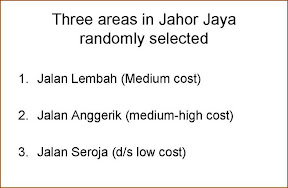
Figure 2
Consumer Preference Test
A comparative description of the test Terrace house and the test Honeycomb house is shown in figure 3. The Terrace house was a commercial design supplied by the Developer. The Honeycomb house was designed by Arkitek M.Ghazali to be as comparable as possible in terms of price (RM220,000 with land), number of bedrooms, bathrooms and carports. However, land sizes and built up areas could not be exactly matched due to the different design constraints imposed by terrace and honeycomb housing and the requirements of the Authorities. The honeycomb house had 11% less built-up area but 24% more land.
Figure 3
The results of the consumer preference test are shown in figure 4. Almost two thirds (66%) of the 150 respondents preferred the Honeycomb House compared to the Terrace house with similar price and features.
Figure 4
The preference by race was also determined. The demographics of the 150 Johor Jaya respondents (figure 5) show them to consist of 58% Chinese, 33% Malays and 8% Indians. Their preference was all considerably higher for the Honeycomb house; 56% amongst Chinese respondents, 58% amongst Indian and 84% amongst Malays. The much higher cultural acceptance amongst Malays confirms our informal surveys at exhibitions and is not surprising since Honeycomb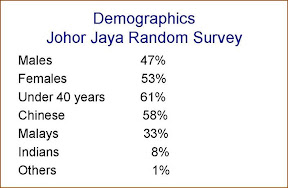
Figure 5
Housing is a scientific urban recreation of the Malay kampong, featuring the essential elements of traditional housing such as a close secure neighbourhood, child friendly outdoor areas and shady native landscaping.
The 58% preference for the Honeycomb house amongst Chinese respondents compared to the terrace house indicated that cultural objections were not strong. This was tested directly in the questionnaire with the statement “This Honeycomb house conflicts with Feng Sui principles”. The response amongst Chinese was equally divided; 50% agreed and 50% disagreed (figure 6).
Figure 6
However, to the next statement in the questionnaire “I will consult a Feng Sui expert before buying a Honeycomb house” (figure 7) only 33 % of Chinese respondents agreed. It would seem that as much as two thirds of Chinese residents in Johor Jaya do not hold strong Feng Sui beliefs and do not consider it necessary to consult an expert before buying a Honeycomb house. Some 61% of the respondents were under 40 years (figure 5). However, in Honeycomb presentations given by Arkitek M.Ghazali to Chinese Developers, their age in general has been over 50 years. It is these Developers, rather than the potential house buyers who are expressing the strong concern that Honeycomb may conflict with Feng Sui and prevent Chinese from buying Honeycomb houses.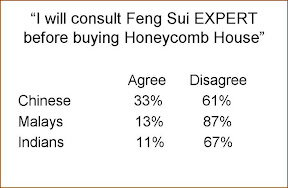
Figure 7
Perhaps it is the older Chinese who hold strong Feng Sui beliefs?
We tested this hypothesis that that Feng Sui beliefs were stronger amongst older Chinese, and that these beliefs were ‘diluted’ in their children’s generation by conducting a 2 tailed t-test. We found the hypothesis to be false. Chinese under 40 versus over 40 years of age showed no significant differences in their responses to the Feng Sui statements shown in figures 6 and 7. Similarly, there were no significant differences between the under and over 50 year old Chinese.
Comparing Terrace and Honeycomb Houses
In this preference test considerable effort was made by Arkitek M. Ghazali to fairly match a Honeycomb house with the Terrace house chosen and designed by the Developer as a suitable house for their next project. Each house type was presented as a fair to the respondents with pictures in similar styles and colours (see appendix 4). The questionnaire required responses to identical set of 8 statements, first about the Terrace house followed by the Honeycomb house (appendix 6)
A scoring system was devised according to the response to each statement:-
Strongly agree 10 points
Agree 7 points
Disagree 4 points
Strongly disagree 1 point
This enabled the response to each statement to be given a ranking on a 1-10 scale which is easily comprehended by the general public. Thus a perfect score of 10 would show that every respondent strongly agreed with the statement; a score of 1 that everyone strongly disagreed. Rather than a crude ‘agree or disagree’comparison this scoring system permitted a detailed quantitative comparison of the Terrace house and the Honeycomb House.
The comparative ‘House Scores’, all beween 6.1 and 7.1 out of 10, are shown in figure 8.
Figure 8
The response to “I like this house” was 6.6 out of 10 for the Terrace house and slightly higher at 6.8 for the honeycomb house showing that both houses were well accepted. Likewise Honeycomb scored higher than Terrace for the other five statements shown in figure 8. The biggest difference was for the community layout. The Terrace scored 6.3 versus 7.1 for the Honeycomb.
The mean overall scores were 6.27 out of 10 for Terrace house and 7% higher at 6.74 out of 10 for the Honeycomb house.
Satisfaction with Present House
The questionnaire (see results in figure 9) also found that 35% of respondents wanted to buy a house within the next 1-4 years, with 22% unsure. Some 37% could afford the RM220,00 price of the Honeycomb and Terrace houses. These two findings were used to calculate the number of potential buyers for either the Honeycomb or the Terrace houses amongst Johor Jaya residents (71% house owners, 29% house renting).
The survey also confirmed earlier findings regarding the most common defects of Malaysian terrace houses (1). The surveyed areas in Johor Jaya consisted entirely of terrace housing. Some 57% of respondents agreed their kitchen was too small,70% agreed their house was too hot and 74% wanted space in their compound for 2 cars (figure 9).
Figure 9
Potential Honeycomb house buyers
We have devised a simple general method, based on random sampling, for determining the number of potential buyers of specific houses amongst residents in a housing area, in this case Johor Jaya. The results are shown in figure 10.
Figure 10
Of the 150 respondents 53 agreed they wanted to buy a house within the next 4 years of which 22 agreed they could afford the selling price of RM220,000 for each of the houses presented.
Seventeen out of 22 preferred the Honeycomb house and only 5 preferred the Terrace house. So out of 150 respondents 17 (11.3%) have clearly indicated they are potential buyers of the Honeycomb house on the basis that they want to buy a house within 4 years, they can afford the RM220,000 price and that they prefer the Honeycomb house.
We can estimate, albeit based on the less than optimum number of respondents, that just over 1000 households (11.33% of 8830 households in Johor Jaya) are potential buyers of the RM220,000 Honeycomb house (figure 11). The corresponding potential customers for the competing RM220,000 Terrace house amongst all races is much less at 298 (5 households in 150 surveyed = 3.33% of 8930 households.
Figure 11
Comparison with Kuala Lumpur Survey
The same questionnaire used in this Johor Jaya survey was used a week earlier to survey those attending a Home Ownership campaign at the Kuala Lumpur Convention Centre (17-19 March 2006). A random survey cannot be carried out at an exhibition or for that matter on the streets or in a shopping centre since the population is continually changing. The next best survey is a systematic survey whereby for instance every tenth adult passing a particular point in the exhibition hall is surveyed. This type of survey was conducted and 101 respondents were shown the set of drawings of the RM220,000 Honeycomb house and the RM220,000 Terrace house. Respondents were also shown a model of a honeycomb community displaying cluster houses surrounding neighbourhood parks. The Kuala Lumpur systematic survey fully confirmed the findings of the Johor Jaya random survey.
The comparison of the Kuala Lumpur housing survey with the Johor Jaya survey is shown in figure 12. Some 77% of the visitors to the Kuala Lumpur Home Ownership Campaign (43% Chinese, 40% Malay and 7% Indian) wanted to buy a house within the next 4 years, 75% preferred honeycomb and 30% were potential buyers of the RM220,000 Honeycomb house. As in the Johor Jaya survey both house types were well accepted in Kuala Lumpur but the House Scores were much higher, reaching 8.7 out of 10 for the Honeycomb house. (figure 13). The percentage of potential Honeycomb house buyers was also very high, 30% of those visiting the exhibition. Feng Sui beliefs were not strong and 24% of Chinese visitors to the housing exhibition were potential Honeycomb house buyers.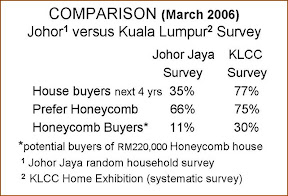
Figure 12
Figure 13
SUMMARY
The Honeycomb house was preferred by two thirds of Taman Johor Jaya residents compared to an equivalent Terrace house. A novel scoring system was used to determine the acceptability of each house. The Honeycomb house scored 6.7 out of 10 whilst the Terrace house scored 7% lower at 6.3 out of 10.
Johor Jaya has 1010 potential customers for the RM220,000 Honeycomb House (352 Chinese, 364 Malays and 294 Indians). This is more than 3 times the 298 potential customers of the equivalent RM220,000 Terrace house.
Considerably higher house scores were obtained for the same houses in an earlier survey of visitors to a Kuala Lumpur housing exhibition where 77% wanted to buy a house within 4 years; the Honeycomb house scored 8.7 out of ten compared to 7.8 for the Terrace house.
Amongst the 3600 Chinese visitors to the Kuala Lumpur housing exhibition 880 (24%) were regarded as potential customers for the RM220,000 Honeycomb house.
CONCLUSIONS
The cultural concern of Developers that Honeycomb housing conflicts with Feng Sui beliefs is largely unfounded. Feng Sui beliefs will not prevent most Chinese from buying a Honeycomb house.
The simple and economic survey techniques described in this study can greatly reduce the commercial risk to Developers and Town Planners. By measuring consumer perception at a very early concept stage of a housing project, the affordability, cultural acceptability and many other factors of new houses and their surroundings can be forecast amongst different sections of the house buying public. This market intelligence can be used to ‘give the customer what they want’ and unite all sections of the housing industry into an efficient supply chain satisfying consumer aspirations for a an affordable quality home in a well planned neighbourhood.
ACKNOWLEDGEMENTS
We thank the Survey enumerators for their excellent and cheerful work. Final year students at Universiti Putra Malaysia:-
Ng Jen Tyng
Ng Chai Moong
Ng Lim Cheng
Tee Chai Ling
Staff of Arkitek M. Ghazali, Desa Pandan, Kuala Lumpur:-
Syuhana binti Khalidi
Ismayanty binti A. Razak
References
1. Mohd Peter Davis, Mazlin Ghazali and Nor Azian Nordin (2006) in ‘Thermal Comfort Honeycomb Housing, the Affordable Alternative to Terrace Housing’, Hardback 186 pages, published by Universiti Putra Malaysia, Serdang. Malaysia.
2. Fred N. Kerlinger (1973) in ‘Foundation of Behavioural Research’, published by Holt, Reinhart and Wilson Inc. New York.
3. Johor Jaya Street Directory (2002), published by Rimman International, containing house numbers.







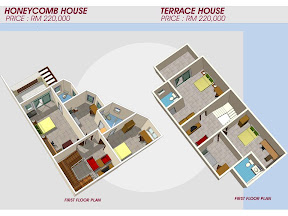
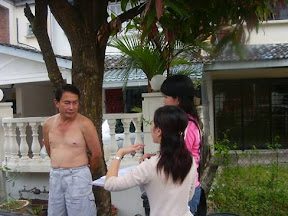

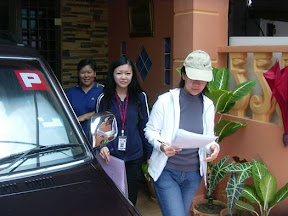

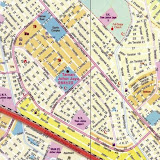
1 comment:
viagra benefits womens viagra viagra and cannabis viagra rrp australia viagra oral generic viagra india how does viagra work cheap herbal viagra guaranteed cheapest viagra viagra suppliers in the uk can viagra be used by women free sample pack of viagra lowest price viagra viagra patent
Post a Comment